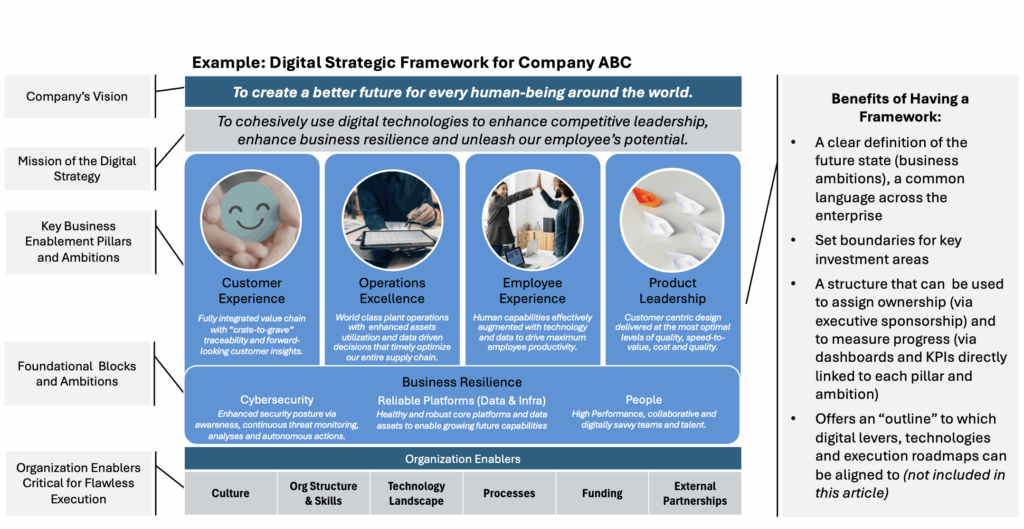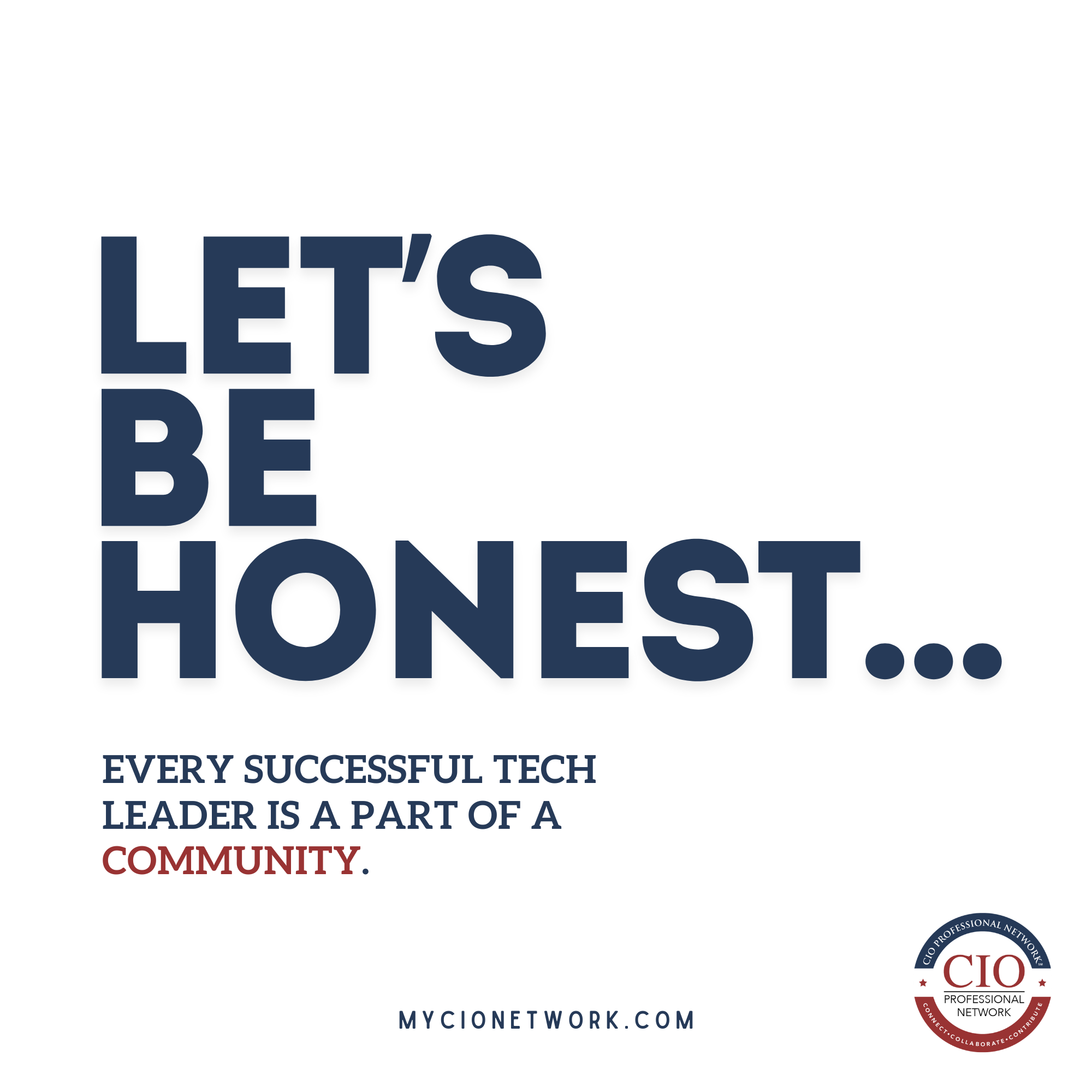Estimates show that 70% to 95% of digital transformation initiatives fail to achieve their intended objectives. Companies that succeed usually see their digital strategy as a transformational enabler for the entire enterprise. These companies do a great job defining and communicating the ambitions of their digital strategy and are able to demonstrate:
1. Direct Alignment with Business Objectives: They ensure that digital investments drive core business outcomes that are interconnected across the enterprise. They leverage technology to bring their vision to life and unlock:
- Customer and Market Responsiveness: By maintaining the proper balance between outside-in needs (customer experience and product leadership) with inside-out needs (operational excellence and employee experience) and using technologies like CRM systems, AI-driven market intelligence, and order visibility platforms, they become well-positioned to better understand and serve their customers. The ability to forecast demand, manage dynamic pricing, and standardize sustainability data also adds a substantial competitive edge.
- Operational Excellence: By digitizing manufacturing processes and integrating IT-OT systems, they enhance plant safety, asset performance, and supply chain efficiency. For heavy asset manufacturing companies or even supply chain and distribution companies, use cases like real-time monitoring and predictive maintenance deliver highly impactful operational gains.
- Empowered Employees: Through digital upskilling, collaborative platforms, and process automation, they boost employee productivity and satisfaction. This, in turn, supports talent attraction and retention, and knowledge management.
- Product Innovation: They leverage digital twins, product information management platforms, and integrated product lifecycle management tools to enable faster and more informed decision-making in R&D. This accelerates innovation cycles and helps maintain product leadership.
2. Increased Agility and Resilience: They balance future capabilities creation with maintaining a strong digital foundation. They emphasize data quality and respond rapidly to cybersecurity threats. They also foster a growth mindset, focusing on creating a digitally savvy workforce and talent pool that embraces business continuity and operational flexibility.
3. Structured and Scalable Execution: Through clear processes for project intake, prioritization, and funding, they ensure that initiatives are aligned, resources are optimized, and execution is accountable. This institutionalizes a culture of value-driven digital transformation.
4. Measurable Impact: Using scorecards and KPIs tied directly to strategic goals, these companies continuously track progress and impact, and course correct using a data-driven approach. This drives transparency and stakeholder trust.
In contrast, organizations that struggle to execute their digital strategy often face challenges in defining and communicating what such a strategy entails.
One of the most critical enablers of any successful transformation is a clear and shared sense of purpose.
Well-designed frameworks serve as practical tools to articulate this clarity, establishing a common language, outlining key building blocks, and ensuring alignment across the organization.
In the tech world, a digital strategic framework is a comprehensive, structured approach that aligns a company’s business priorities with digital initiatives. At its core, and when powered by enterprise thinking and cross-functional collaboration, it brings attention to important building blocks that enable an organization to strengthen its competitive advantage and unlock the full potential of its workforce through the effective use of meaningful technology.
But What Exactly Does a Digital Strategic Framework Look Like?
There are no right or wrong answers for what the framework should look like.
As a matter of fact, many research and consulting firms have a few of them that can easily be adopted. It is crucial, though, that technology leaders take the time to select and/or adapt the design that best fits their current organization’s needs.
In a nutshell, the framework should be something as simple as a one-pager that primarily helps executives and individual contributors “connect the dots“ and clearly communicate how the “mission of digital” aligns with the company’s vision.
Pillars or building blocks can be used to set investment buckets and a common definition of the future state, also known as ambitions.
“Technology never happens for the sake of technology alone.”
In a perfect world, CIOs/CDOs should align the application of technology to existing business strategic pillars or imperatives. However, if the company does not have those defined, s/he can work with their stakeholders to structure the deliverables around four main business enablement pillars:
1. Customer Experience
2. Operations Excellence
3. Employee Experience
4. Product Leadership
Regardless of which pillars best fit your current organization, I recommend that they are also supported by a foundational building block that drives:
5. Business Resilience
Adding Business Resilience as a foundational part of the strategy matters because, at the end of the day, strategy is not only about creating new capabilities for the future. It is also about ensuring that IT business partners have a reliable technology landscape and experience to rely on, day-in/day-out.
Usually, the foundational pillar for Business Resilience covers topics such as Cybersecurity, Core Platforms for Infrastructure, Applications and Data, and most importantly, People (technical and leadership talent plus strategies to enhance the overall organization’s digital literacy).
“Strategy is about what we are going to do now in order to shape the future to our advantage.”
Each of the components of the framework must have a definition (think of an ambitious destination or end state) and behind them, a set of digital levers, technologies, and roadmaps that turn strategy into action.
Splitting deliverables into business enablement and foundations also gives the organization a structured way of making important decisions, such as:
- Prioritizing the level of investment. Leaders can distribute investment based on business needs.
- For heavy manufacturing-driven companies, for instance, it is not uncommon for 50-60% of total new investment to go into the Operational Excellence pillar.
- Building subject matter experience. Each pillar can be identified as a domain of knowledge around which IT can build skills.
- For instance, we all know that customer-facing technologies require a very different skill set and domain knowledge than the technologies we need to run the shop-floor or a distribution center.
- Securing business sponsorship. Technology never happens for the sake of technology alone. The best digital initiatives start strong with the proper level of executive sponsorship. Sponsors help to co-design the expected business value and outcomes. Having a framework with business enablement pillars allows the IT function to recruit senior business sponsors for each and strengthen the partnership, not only between IT and the functions, but also across each function.
- For example, for customer experience, the executive sponsor could be the Chief Commercial Officer; for Operations Excellence, the executive sponsor could be the Chief Operations Officer or the Chief Manufacturing Officer, etc.
These leaders help to set the vision and galvanize the strategy across the organization.
It is important to mention that executive sponsors become exponentially important when operating in a heavily matrixed organization.
Finally, to complement these pillars, we can’t ignore the organizational enablers, which are equally important to make the digital strategy executable.
In my experience, these enablers are initially applicable to the IT organization.
Over time, once these enablers start delivering the value prescribed, naturally, the other functions start to also adopt them. The credibility of IT improves, and cross-functional collaboration meets new highs.
These enablers are:
- Culture: The mindset required to foster digitally literate, change-ready, innovation-driven teams, supported by leadership commitment and transparent communication.
- Organizational Structure, Operating Model, and Skills: The alignment of the team under a strong unified leadership (the Team One), the establishment of a business-centric operating model, and domain-expert teams supported by a strong career framework.
- Technology: The shift from sole point solutions to the enterprise thinking of an end-to-end architecture (interoperating, robust technologies to solve real business problems across infrastructure, applications, data, and security).
- Processes: The adoption of disciplined portfolio intake, prioritization, measurement, and execution methods.
- Funding: The alignment of investment strategies to value creation with clear visibility and agility.
- External Partnerships: The partnerships with tech leaders, service providers, and research organizations to deliver a shared vision.
All these pieces fit together like a puzzle. A system of systems that, when well balanced and integrated, creates an environment of partnership, a culture of high performance, and a catalyst for meaningful and sustainable change.

The Wrap
A digital strategic framework represents how an organization thoughtfully and systemically integrates technology into its operating model.
Companies that build and evolve such a way of thinking are better positioned to lead, adapt, and grow.
Whether the focus is sustainability, exceptional customer experience, or operational excellence, a clear digital strategy framework becomes a critical engine of transformation and resilience. It eventually becomes the compass that helps to guide the enterprise towards meeting its digital ambition.
Trusted insights for technology leaders
Our readers are CIOs, CTOs, and senior IT executives who rely on The National CIO Review for smart, curated takes on the trends shaping the enterprise, from GenAI to cybersecurity and beyond.
Subscribe to our 4x a week newsletter to keep up with the insights that matter.






